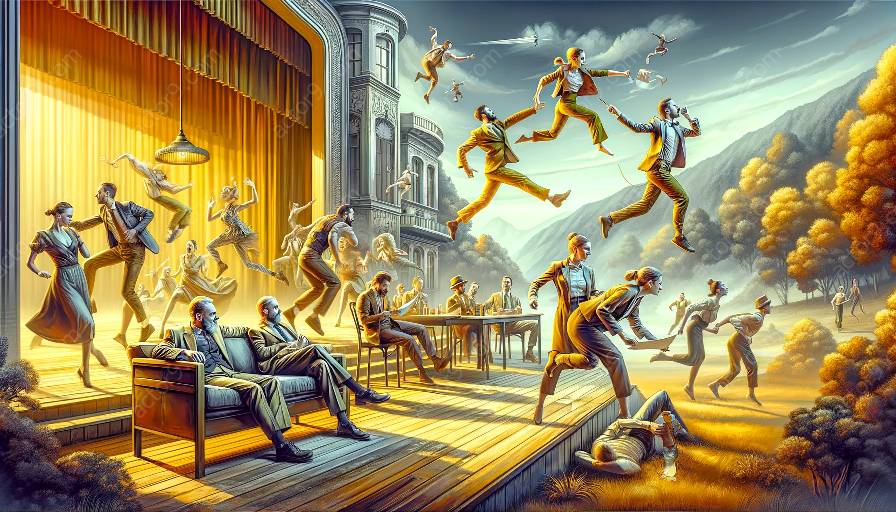Educational theatre productions often incorporate physical comedy to engage and entertain audiences while conveying important lessons and messages. Physical comedy is a prominent element of comedic aspects of physical theatre, adding visual humor and exaggerated movements to enhance storytelling. This article explores some examples of physical comedy used in educational theatre productions and their relevance to the broader concepts of comedic aspects of physical theatre and physical theatre.
Understanding Physical Comedy in Education
Physical comedy is a form of comedic expression that relies on exaggerated movements, gestures, and facial expressions to elicit laughter and entertainment. In educational theatre productions, the use of physical comedy serves multiple purposes. It can engage students of all ages, enhance the learning experience, and provide a platform for exploring complex themes in a lighthearted manner.
Furthermore, physical comedy in educational theatre often involves interactive elements that encourage audience participation and active engagement with the material being presented. This creates a dynamic and immersive experience that can leave a lasting impression on the audience, making it an effective tool for conveying educational messages.
Examples of Physical Comedy in Educational Theatre Productions
1. Exaggerated Gestures and Expressions: In educational theatre productions, actors often use exaggerated gestures and facial expressions to communicate emotions and ideas in a comedic manner. This can involve oversized movements, slapstick humor, and playful interactions with props and other performers.
2. Physical Mishaps and Fumbles: Incorporating physical mishaps and fumbles into the storyline can create comedic moments that entertain while subtly conveying valuable lessons. These comedic elements can range from simple clumsiness to elaborate, choreographed sequences that showcase the actors' physical prowess.
3. Comedic Movement and Choreography: Choreographed routines and movements can infuse educational theatre productions with humor and entertainment. This can include synchronized dances, comical chase sequences, and dynamic physical interactions that add a layer of amusement to the overall performance.
4. Interactive Playfulness: Engaging the audience in playful interactions and physical games can turn educational theatre productions into memorable experiences. Actors may break the fourth wall, involve the audience in comedic scenarios, or encourage participation through physical gestures and prompts.
Comedic Aspects of Physical Theatre
Comedic aspects of physical theatre encompass a wide range of techniques and styles that contribute to the overall humor and entertainment value of a performance. These include:
- Exaggerated Physicality: The deliberate exaggeration of physical movements and expressions to create humor and comedic effect.
- Acrobatics and Circus Skills: Incorporating acrobatic feats and circus skills into physical theatre performances to amuse and engage the audience.
- Slapstick Comedy: Utilizing physical pranks, mishaps, and humorous violence to elicit laughter and entertainment.
- Mime and Physical Expression: Communicating ideas and narratives through silent gestures, miming, and physical storytelling.
These comedic aspects intertwine with physical comedy in educational theatre productions, enhancing the overall impact of the performances while conveying educational content in an engaging and memorable manner.
Exploring the Role of Physical Comedy in Education and Entertainment
Physical comedy in educational theatre productions not only entertains but also educates through the ingenious use of humor and exaggerated physical expressions. It challenges traditional teaching methods by providing an innovative and immersive approach to learning. By embracing physical comedy as a valuable tool for education and entertainment, educational theatre productions create an environment that fosters creativity, critical thinking, and emotional intelligence.
Furthermore, physical comedy serves as a bridge between education and entertainment, appealing to diverse audiences and breaking down barriers that may hinder traditional forms of learning. By infusing educational content with humor and physicality, educational theatre productions create experiences that captivate, inspire, and leave a lasting impact on participants.
In conclusion, the use of physical comedy in educational theatre productions not only exemplifies the comedic aspects of physical theatre but also demonstrates the power of laughter as a catalyst for learning and understanding. Through interactive, entertaining, and educational performances, physical comedy becomes a transformative force in the realm of educational theater, shaping the way we approach learning, creativity, and expression.




































